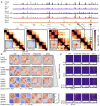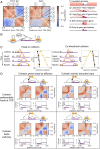Transcription shapes 3D chromatin organization by interacting with loop extrusion
- PMID: 36897969
- PMCID: PMC10089175
- DOI: 10.1073/pnas.2210480120
Transcription shapes 3D chromatin organization by interacting with loop extrusion
Abstract
Cohesin folds mammalian interphase chromosomes by extruding the chromatin fiber into numerous loops. "Loop extrusion" can be impeded by chromatin-bound factors, such as CTCF, which generates characteristic and functional chromatin organization patterns. It has been proposed that transcription relocalizes or interferes with cohesin and that active promoters are cohesin loading sites. However, the effects of transcription on cohesin have not been reconciled with observations of active extrusion by cohesin. To determine how transcription modulates extrusion, we studied mouse cells in which we could alter cohesin abundance, dynamics, and localization by genetic "knockouts" of the cohesin regulators CTCF and Wapl. Through Hi-C experiments, we discovered intricate, cohesin-dependent contact patterns near active genes. Chromatin organization around active genes exhibited hallmarks of interactions between transcribing RNA polymerases (RNAPs) and extruding cohesins. These observations could be reproduced by polymer simulations in which RNAPs were moving barriers to extrusion that obstructed, slowed, and pushed cohesins. The simulations predicted that preferential loading of cohesin at promoters is inconsistent with our experimental data. Additional ChIP-seq experiments showed that the putative cohesin loader Nipbl is not predominantly enriched at promoters. Therefore, we propose that cohesin is not preferentially loaded at promoters and that the barrier function of RNAP accounts for cohesin accumulation at active promoters. Altogether, we find that RNAP is an extrusion barrier that is not stationary, but rather, translocates and relocalizes cohesin. Loop extrusion and transcription might interact to dynamically generate and maintain gene interactions with regulatory elements and shape functional genomic organization.
Keywords: chromatin organization; cohesin; genome organization; loop extrusion; transcription.
Conflict of interest statement
The authors declare no competing interest.
Figures




References
-
- Banigan E. J., Mirny L. A., Loop extrusion: Theory meets single-molecule experiments. Curr. Opin. Cell Biol. 64, 124–138 (2020). - PubMed
-
- Yatskevich S., Rhodes J., Nasmyth K., Organization of chromosomal DNA by SMC complexes. Annu. Rev. Genet. 53, 445–482 (2019). - PubMed
-
- Davidson I. F., et al. , DNA loop extrusion by human cohesin. Science 366, 1338–1345 (2019). - PubMed
Publication types
MeSH terms
Substances
Grants and funding
LinkOut - more resources
Full Text Sources
Molecular Biology Databases
Research Materials

